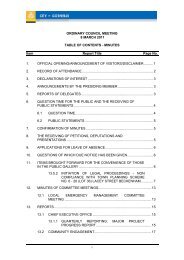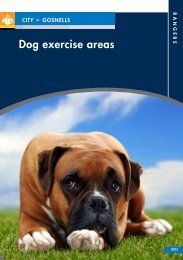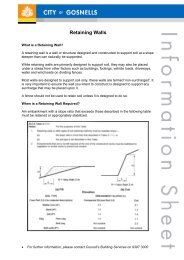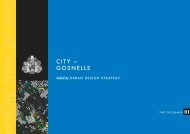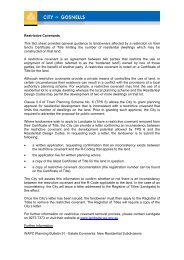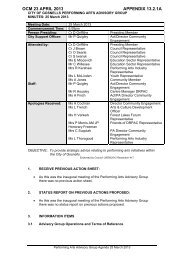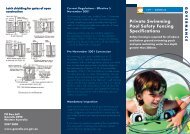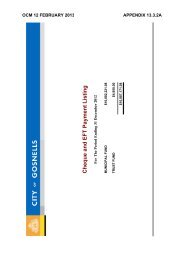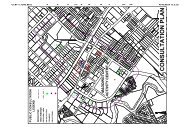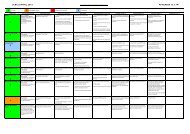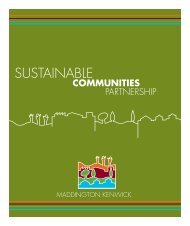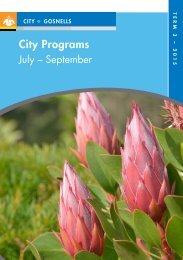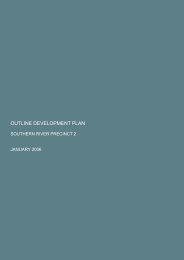Summary - City of Gosnells
Summary - City of Gosnells
Summary - City of Gosnells
You also want an ePaper? Increase the reach of your titles
YUMPU automatically turns print PDFs into web optimized ePapers that Google loves.
Wetlands Field Survey 816.1 Identification and delineation <strong>of</strong> wetlands in the MKSEAThe identification and delineation <strong>of</strong> wetlands relies on the characterisation <strong>of</strong> the hydrology, hydric soilsand vegetation (Hill et al., 1996; Tiner,1999) and a general guide for this is provided in DEC (2007). Inaccordance with these principles, investigations were conducted to distinguish between putative wetland andupland zones in the MKSEA. A limited field survey <strong>of</strong> the hydrology and shallow stratigraphy <strong>of</strong> thevegetated wetlands <strong>of</strong> the MKSEA that are mapped in DEC (2008a) was undertaken in addition to thedetailed flora and vegetation study reported above. Obligate and facultative wetland flora plants at eachstudy site in the survey area and elsewhere were noted during the flora and vegetation survey (Appendix D).In the current survey, the uplands <strong>of</strong> the MKSEA were found to be either naturally elevated landforms ormore low-lying areas where the land surface had been elevated above the high watertable <strong>of</strong> the surroundingterrain by the importation <strong>of</strong> sand (or other fill materials). The natural upland areas <strong>of</strong> the MKSEA were alldeep Bassendean Sands. The boundaries between the natural uplands <strong>of</strong> the area and the wetlands (that wereall underlain by muddy sediments <strong>of</strong> the Guildford Formation or shallow sand over muddy sediments) weresubtle in some areas and difficult to map. The locations <strong>of</strong> these boundaries are provisionally indicated(Figure 11). However, they will require detailed topographic survey and further study <strong>of</strong> hydrology andstratigraphy to map at a finer scale prior to a final determination <strong>of</strong> development and buffer zones. Therewere two main locations <strong>of</strong> boundaries <strong>of</strong> this type in the MKSEA.• In Precinct 2 <strong>of</strong> MKSEA there was an irregular boundary between the Pinjarra Plain wetlands and theBassendean Dune uplands that extended obliquely from Tonkin Highway (just south <strong>of</strong> Brentwood Rd) toVictoria Rd. This was a sensitive boundary in terms <strong>of</strong> the very high natural conservation values that arelocated in several areas along this boundary and the wetland processes that still operate along the areaswhere native vegetation has been cleared.• In Precinct 1 the boundary above continued along the contact between the Pinjarra Plain wetlands and theBassendean Dunes and divided this precinct into an upland zone in the north east and a wetland zone inthe south-west.The artificially raised areas throughout the MKSEA were mapped, very approximately, from aerialphotographs, as non-wetlands. This mapping was also not a definitive assessment and there was notsufficient access to many properties to verify the location <strong>of</strong> many areas <strong>of</strong> fill. This mapping does, however,provide an indication <strong>of</strong> the scale and pattern <strong>of</strong> the (largely unregulated) filling <strong>of</strong> the local wetlands.There was ample evidence <strong>of</strong> hydric soils, high water tables and surface and groundwater dependantvegetation indicative <strong>of</strong> wetland conditions in most <strong>of</strong> the sample sites representative <strong>of</strong> the MKSEA in thecurrent survey (Table 6.2). The native vegetation <strong>of</strong> most <strong>of</strong> the MKSEA had predominantly obligatewetland species in the areas <strong>of</strong> shallow sand over Guildford Formation and in areas <strong>of</strong> clayey sands andsandy clays. Most <strong>of</strong> the areas mapped as wetlands in the SCP Wetland Dataset (DEC, 2008a) wereconfirmed as wetlands in the current survey (Figure 11). There was also an additional wetland area identifiedin the current survey that had not been mapped previously as wetland area in DEC (2008a).The boundaries between the extensive palusplains and the Bassendean Dune uplands that were mapped in thecurrent survey (Figure 11) differ somewhat from the boundary mapped in the SCP Wetland Dataset (Figures9 and 10). There was also an additional wetland area identified in the current survey that had not beenmapped previously as wetland area in DEC (2008a). To provide the evidence necessary to support amodification <strong>of</strong> the wetland boundary in the SCP Wetland Dataset (i.e. to more accurately delineate thewetlands in this area prior to any planning decisions), a fine scale hydrogeological study to describe thestratigraphy and the hydrology <strong>of</strong> the wetlands along the interface <strong>of</strong> the wetlands and the Bassendean Dunesis recommended. It is likely that Muchea Limestone aquifers in the MKSEA are closely connected towetlands in BFS 387. The occurrences <strong>of</strong> Muchea Limestone in the MKSEA (and the catchment areas <strong>of</strong> theaquifers associated with these occurrences) require further investigation and detailed mapping to understandhow these wetlands are maintained and how they interact with the Greater Brixton Street Wetlands.Subsequently, measures can be taken to protect catchment areas, conserve and restore wetlands in theMKSEA and link them via vegetated corridors to bushlands reserved in the Greater Brixton Street Wetlands.Tauss, C. and Weston, A.S. (2010). The flora, vegetation and wetlands <strong>of</strong> the Maddington-Kenwick Strategic Employment Area.A survey <strong>of</strong> the rural lands in the vicinity <strong>of</strong> the Greater Brixton Street Wetlands. Report to the <strong>City</strong> <strong>of</strong> <strong>Gosnells</strong>, W.A. Version 18.04.10



